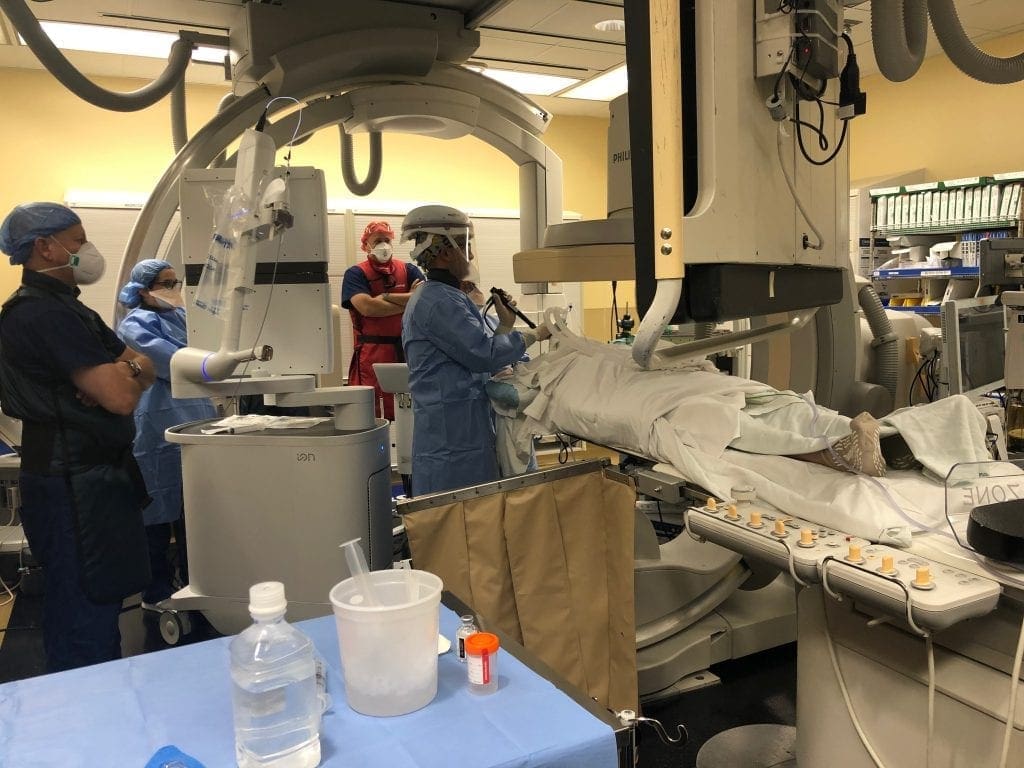Metro Health – University of Michigan Health, as part of the Cancer Network of West Michigan, is pioneering the use of an advanced robotic system to diagnose lung cancer at the earliest, hardest-to-reach stages, improving hope for survival from this No. 1 cause of cancer death.
“Historically, most lung cancer diagnoses were late. When we are able to detect, diagnose and treat sooner, we can help a patient outlive the cancer,” said Dr. Mounir Ghali, Director of Interventional Pulmonology at Metro Health.
Ghali and Metro Health are addressing the challenge of early detection with the region’s first Ion robotic-assisted bronchoscopy tool, allowing faster, more precise and minimally invasive biopsies. Ghali started using the system September 21st.
Early stage cancers typically are very small and located in hard-to-reach parts of the lung. The Ion robot’s shape-sensing technology allows Ghali to precisely guide a thin catheter through the patient’s mouth into the airway tree, and safely perform a biopsy – even in the smallest and most remote regions of the lung.
The procedure takes an hour or less. Patients go home after recovering from anesthesia and can return to work the next day.
“As part of the Cancer Network of West Michigan, a progressive regional collaboration with Mercy Health and Michigan Medicine, Metro Health is committed to innovation that provides hope for people in our community who are facing cancer,” said Dr. Peter Hahn, President and CEO, Metro Health – University of Michigan Health.
“The Ion system offers significant advantages to previous bronchoscopy technology,” said Hahn, who also is a pulmonologist. “This exemplifies our constant efforts to improve options for patients facing the possibility of lung cancer. Not only is Dr. Ghali a board-certified, fellowship-trained interventional pulmonologist, he is now equipped with the most advanced tool available in the world for fast, safe and accurate diagnosis.”
The Ion robotic bronchoscopy is used with cone beam CT tenchonology to generate a three-dimensional road map to the target area. The computer acts as a sort of GPS while a vision probe allows a real-time view inside the airway as the physician guides a 3.5-millimeter catheter along the path.
The catheter’s narrow diameter and maneuverability allow it to safely twist though tight corners, reaching all segments of the lung. The Ion also is compatible with existing equipment, including scanning devices that support real-time navigation. Once the target is reached, a needle inside the catheter collects the biopsy.
The Ion robotic bronchoscopy complements the work of Metro Health’s Lung Cancer Screening Clinic, which conducts scans on high-risk patients to discover potential problems. If a scan reveals nodules, a biopsy is required for diagnosis.
“The life-saving potential of the Ion robot illustrates the importance of lung screenings as a first step,” said Dr. Terrance Barnes, who conducts the screenings for Metro Health.
“Lung screenings are essential to our overall strategy for improving cancer outcomes,” Barnes said. “Studies show lung screenings help reduce cancer deaths, especially when combined with smoking-cessation programs.”
Doctors and researchers agree quitting smoking is the most important step to preventing lung cancer. Patients wondering about their risk factors should talk to their physician or explore the lung-screening information on Metro Health’s website.
